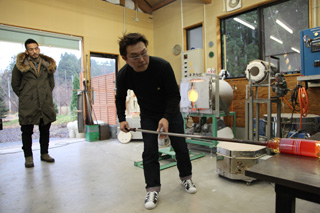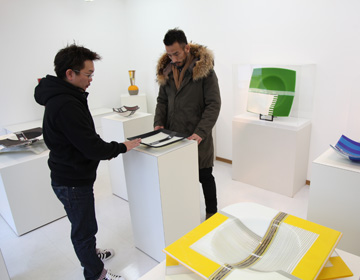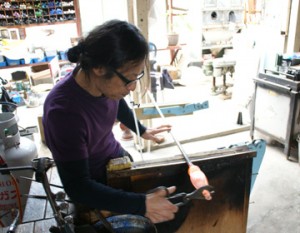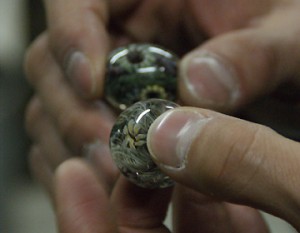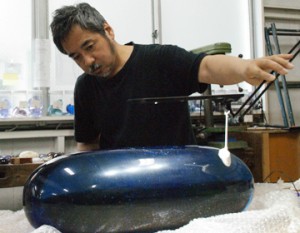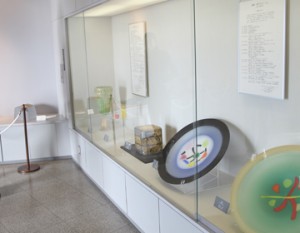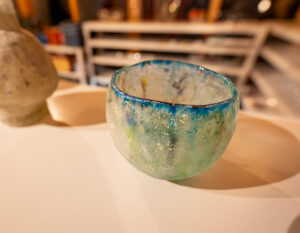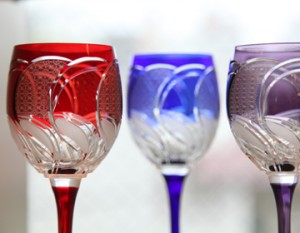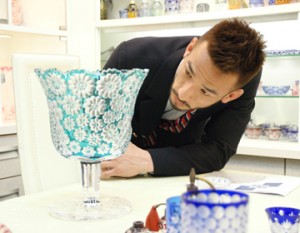Colorful glass works
Large plates and receptacles. Many pretty colors are used, and one look and you’ll be fascinated. However, Hisao Nabeta’s works are not only that. The receptacles have beautiful curves, and the colors ”flow” in the glass. The flowing colors are made using a technique to combine different colored glass, and heat and melt them together. The method he explained was surprising. He uses gravity to transform the shapes.
First, glass plates or glass sticks of different colors are combined to determine a design. A mold made of fire-proof plaster with a hole is prepared, and legs are attached underneath. The colored glass pieces are placed on the mold, and placed in an electric oven. As the temperature rises, the glass melts slowly, and by the force of gravity, gradually stretches down the hole. This creates the flowing form of the receptacles.
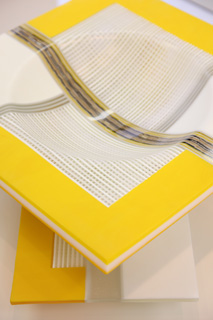
Taking time to slowly form the receptacles
When we observed at the glass that had cooled after it was taken out of the oven, we understood what Nabeta meant by gravity. The molten glass is made to slide into the plaster mold. It’s very interesting, but it is an extraordinary procedure. Imagine a vase, for example. A vase with distorted shape may be charming, but Nabeta’s vase has a very refined curve. To produce that shape, the molten glass must sink evenly into the plaster mold. The glass has to be heated very slowly for this to happen, much slower than the process used for other glasswork.
Furthermore, heat must be conducted evenly, so you cannot use the corners of the oven. The glass has to be heated in the center of the oven so the heat is transmitted evenly. Therefore, not many vessels can be made at once.
”And the vessels have to be taken out of the plaster molds, and the edges have to be cut. This is quite a difficult process. It takes up half a day. If you are not careful, they break easily. ”
It is indeed a fine piece, requiring a lot of work and time.
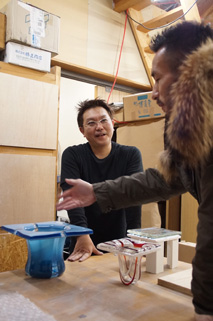
Expressing “wa” through glass
The technique Nabeta mainly uses is called fusing, where designs are created by combining glass sticks. It is an old technique, but one that requires high degree of skills because the expansion rate of glass varies when heated. As a result, it gradually gave way to glass blowing. Nabeta also uses glass blowing and other techniques.
However, the expressions that can be achieved by fusing cannot be matched by glass blowing. However long it may take, one must begin by arranging the glass plates and melt them slowly together.
And what is striking about Nabeta’s pieces is the color and the design. Many colors, especially bright yellow and red, draw one’s attention. Another characteristic is that his designs have Japanese elements. Many of his works skillfully fuses Japanese elements such as designs inspired by ”kimono” or Japanese architecture.
One gets the impression that glass work is an imported artform. Perhaps that is why we find Nabeta’s pieces to be so intriguing – because he expresses ”wa” using glass.
